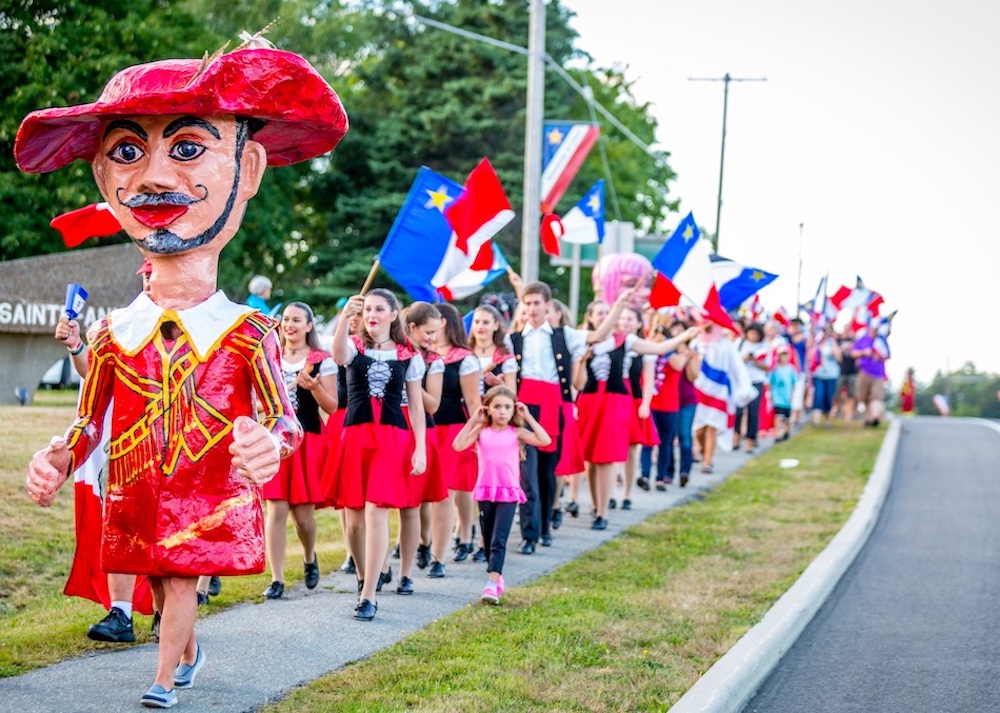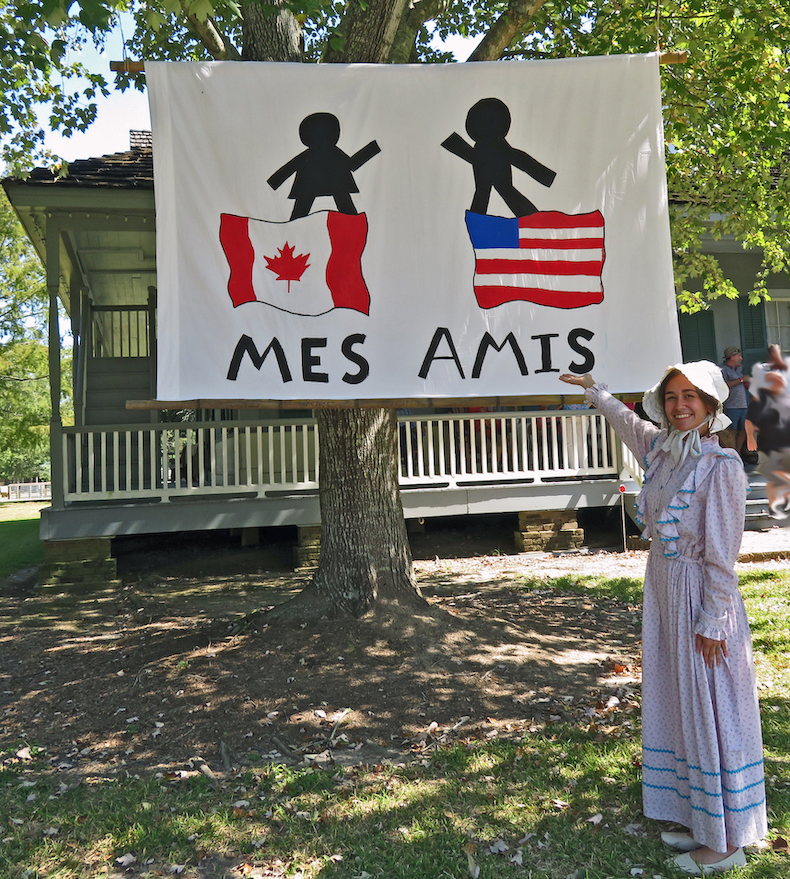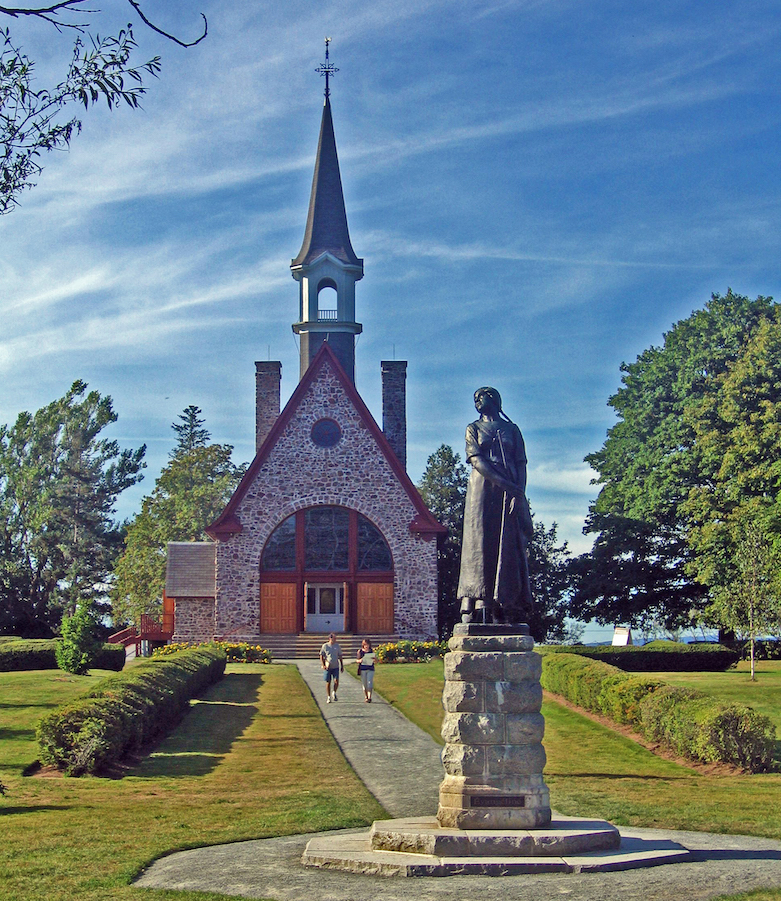
Canada’s Festival Acadien de Clare brings French-speaking Acadian families together to celebrate their culture, language, and survival of the Grand Dérangement . Photo courtesy of Clare Tourism
By Liz Campbell
The room is full, and every foot is tapping. One musician plucks an unusual double bass made from a steel drum. A dozen others play their fiddles, guitars, accordions and drums. This is the weekly Saturday afternoon jam session at Vermilionville Living History Museum and Folklife Park in Lafayette, Louisiana.
The historic 18th and 19th-century buildings in this 23-acre park – homes, a forge, the trapper’s cabin and, of course, the Catholic church – tell the story of the early French-speaking Acadians who settled here. These newcomers adopted the best of Indigenous, Spanish and African cultures, and became known as Cajuns, the Southern pronunciation of Acadian. The infectious beat of the music being played on this Saturday afternoon is born of those same cultural elements.
But just 100 yards away, inside the 1890 vintage schoolhouse, there’s a reminder of less happy history. I will not speak French has been laboriously written 100 times on the blackboard. It’s easy to imagine the humiliation of the child enduring this punishment for speaking his native language in a state that was actually first colonized by France and named for a French king.
“In the early 20th century, French was banned in Louisiana schools. Back then, if you were Cajun and spoke French, people thought you were an ignorant country bumpkin,” says the costumed guide at Vermilionville. “In a couple of generations, French was nearly wiped out.”
Ray Trahan is the founder of Louisiana-Acadie, an organization that provides a united voice for the Acadians of Louisiana. “My parents could only speak French so that was my first language. But they always told me to forget my French and only speak English,” he says. “Well, I kept speaking French because that’s the only way I could communicate with them and my grandparents, but I was always ashamed of my French.”
Today, organizations like Louisiane-Acadie are encouraging the protection and revival of Acadian culture and the French language with events like this year’s Le Grand Réveil Acadien (The Great Acadian Awakening). Held every four years, these nine days of festivities are centered around Lafayette and nearby small communities like Abbeville, Broussard, and Church Point. The festival welcomes Acadians from all over the world, bringing together branches of families once brutally scattered. And this year, as always when they gather, they remember the tragic events that scattered them.

Acadians in Canada and Louisiana are united by history, language and culture explains Acadia Parish Tourism official Stevie Robinson. They have a story to tell and they can tell it in French or English. Photo by Liz Campbell
The first Acadians
Their story begins in 1632, when these first European settlers were brought over from France to colonize land which is now part of the Canadian provinces of Nova Scotia and New Brunswick. They called their new land Acadie. The Acadians were hard-working farmers and fishermen, who formed strong alliances with the two main Aboriginal tribes of the area, the Mi’kmaqs and the Maliseet.
But in the 18th century, the Anglo-French Wars (also known as the French and Indian War) saw France and England battling for North America. The independent Acadians refused to support either side; it was a neutrality that would prove fatal. In 1755, the British captured Fort Beauséjour and Governor Charles Lawrence gave the French-speaking Acadians a choice: swear allegiance to Britain or face deportation. They refused.
Neutrality Brings Banishment
Their homes destroyed, and their cattle gone, 10,000 Acadians – nearly the entire population – were crammed into overcrowded ships and packed off to English Protestant colonies along the Eastern seaboard of America, or to France, or the Caribbean. This was the Grand Dérangement – the Great Upheaval. “They could only take what they could carry and they were scattered to places where they often couldn’t speak the language,” says Danny Blinn, a heritage interpreter at Rendez-vous de la Baie Visitor Center, an Acadian history museum in Church Point, Nova Scotia. “Families were broken up, and spent many years wandering, trying to find each other. It’s believed that as many as half of those sent away died.”
Some exiles eventually made their way back to Acadie, only to find the land they had cleared and cultivated in the fertile Annapolis Valley was now in British hands. Many turned to fishing and built new lives in Southwest Nova Scotia. Brightly painted houses and soaring church spires distinguish Acadian towns like Church Point, Clare, Argyle, and Saulnierville, communities that boast some of the most bilingual populations in Canada.
Museums in the area, like Rendez-vous de la Baie, tell their story. At nearby Village Historique Acadien, costumed interpreters knot fishing nets, build boats, and hook rugs, weaving the history of their ancestors into the demonstrations.

Cajun children learn family traditions and the French language by accompanying their parents to Acadian festivals. Their shirts say “Ici on parle français” or French is spoken here. Photo by Brady Broussard
Living History and Lobsters
On the docks in West Pubnico, against a background of fishing boats, Louise Deveau of Living Wharves talks about the hard life of a lobster fisherman. She teaches visitors to braid and splice a rope, and has the audience laughing at her description of the first time she learned to bait lobster traps – with smelly, rotting fish!
At the Acadian Museum of Pubnico, a group of ladies stitch busily at a quilt cross-patched with prismatic squares, chattering in a mix of French and English as they work. Downstairs in the large vault, extensive records are carefully maintained for those coming back to Nova Scotia to research their Acadian family history.
Most of the exiles never would return, forced to build new lives elsewhere. In 1764, one group made their way to Southern Louisiana, where they could speak French and importantly, practice their Catholic faith. In fact, Louisiana is still divided into parishes, not counties, as are most American states. Here, although Acadians built new communities, their tragic story was never forgotten.

Before the Grand Dérangement, The Nova Scotia settlement of Grand Pré was a thriving Acadian community. Today, the confiscated farms have been reacquired and turned into the Grand Pré National Historic Site. It is a pilgrimage site for Acadians who come to see Memorial Church and the statue of Evangeline. Photo by Liz Campbell
A Fateful Dinner Party
Fast forward 80 years, to a dinner party in New England where American poet, Henry Wadsworth Longfellow, was a guest. The host, Rev. Horace Connelly, recounted the Acadian story and a dramatic tale of a young couple separated by the Great Upheaval. Longfellow was so moved by the tragedy, that he wrote Evangeline, A Tale of Acadie. In his poem, Evangeline, torn on their wedding day from her husband-to-be, Gabriel, searches far and wide for her lost love.
Published in 1847, the poem became so popular it eventually went through 270 editions and more than 100 translations. It became required reading in many American schools. Indeed, people began to believe Evangeline was actually a historic person.
In 1930, a statue to this mythical heroine, designed by Québec sculptor Louis-Philippe Hébert, was erected at Grand Pré National Historic Site in Nova Scotia.
Before the Grand Dérangement, Grand Pré was a thriving Acadian community which Longfellow described idyllically:
Neither locks had they to their doors, nor bars to their windows;
But their dwellings were open as day and the hearts of their owners;
There the richest was poor, and the poorest lived in abundance
People wanted to see this paradise and pay homage to its mythical heroine. The Evangeline statue and the Memorial Church behind it became a site of pilgrimage for Acadians from around the world. More importantly, these concrete symbols kept alive the tragic story of the Acadian expulsion and forged bonds between the Acadian communities in Canada and those elsewhere, particularly in the US.
Let the Good Times Roll
Those relationships continue to grow, and exuberant events like this Grand Réveil Acadien in Louisiana, and the annual Festival Acadien de Clare, in Baie Ste Marie, Nova Scotia, strengthen those ties, bringing Acadians from both countries together. But while they share a history and language, as with the music, the cuisine in Louisiana has evolved.
In Canada, Acadian cuisine has remained true to its early roots with dishes like râpure or rappie pie (pulled chicken or pork topped with mashed potatoes and baked to a crisp golden brown), fricot (a hearty chicken or seafood stew), or pets de soeurs (translated as nun’s farts, these sweet treats are similar to cinnamon rolls). But Cajun cuisine in Louisiana is more complex since it augments original French dishes with African, Spanish, and Indigenous spices Cajuns encountered when they arrived.
Le Grand Réveil actually includes two cooking competitions. The Jambalaya cook-off in Broussard features at least a dozen variations of this spicy classic rice and meat dish, with more than a few similarities to Spanish paella.
And today, at the Great Cajun Cook-Off in Church Point, Louisiana, the air is scented with the rich aroma of gumbo and crawfish stew, and the sugary scent of deep fried, beignets (doughnuts). Under small tents, a dozen or more chef wannabees stir giant pots and wield spatulas.

Sharon Ledoux makes crawfish and shrimp fricassee better than anything you’ll find in New Orleans, she insists. The lobsters that migrated to Louisiana with Nova Scotia’s Acadians are today’s crawfish. Smaller but just as tasty, says Ledoux. Photo by Liz Campbell
Gumbo for the Soul
Sleeves rolled up, Ray Trahan and Randy Menard, president of Louisiane-Acadie, are stirring an enormous cauldron of gumbo, a thick soup/stew made with chicken stock with added meats or seafood. Unlike its Canadian version, this one is spiced with cayenne. Okra was traditionally used as a thickener and the name gumbo is thought to come from the West African word for okra, ki ngombo. It’s hard to resist a sample of this zesty, appetizing soup.
“This is real Cajun food,” says competitor Sharon Ledoux, stirring her entry, a rich crawfish and shrimp fricassee. “Not like some of the stuff they serve in New Orleans and call it Cajun!” There are nods of agreement from locals gathered around her tent, waiting for a sample. Cajuns love their capital city, but those press accolades for signature Cajun restaurants in New Orleans are met with unanimous disdain. And when the discussion moves to authentic Cajun ingredients, Stevie Robinson, a young staffer with Acadia Parish Tourism, tells a story.
Crawfish: Small but Still Tasty
“When the Acadians were expelled from their homes in Canada, the lobsters were sad, and followed them south. It was a very long journey,” she says solemnly. Then she adds to knowing laughter from the group gathered around the tent, “By the time they got to Louisiana, the lobsters were much smaller and maigre (thin). They had turned into crawfish! That’s why Cajuns love crawfish so much!”
In Louisiana, food is often a metaphor for the Acadian experience. “Our Acadian culture is like a gumbo,” explains Marie Ducote. “Acadians blend and accept improvements, like African and Spanish spices, but we remain true to ourselves.”

Cajuns in South Louisiana come together to speak French at gatherings called “French Tables.” English speakers are invited to attend so they can improve their French. Photo by Liz Campbell
Ici on parle Français
Ducotte runs Cajun Food Tours in Broussard, Louisiana, and gumbo at Ton’s, one of the area’s oldest Cajun eateries, is a must on the tour’s sampling menu. But beyond showcasing the food of her grandparents, she has started to add French to her tours to accommodate French-speaking tourists. “My generation grew up without French,” she says. “I’m in my fifties, and I’m relearning the language my parents spoke when I was a child.”
We meet at a ‘French Table’ in the historic Valsin Broussard House in her town. French Tables, found in homes and community centers throughout southern Louisiana’s Acadiana region, are informal gatherings of those who would like to converse in French in order to improve their skills. Encouraged by the Council for the Development of French in Louisiana (CODOFIL), French Tables even welcome visitors to join locals at the monthly gatherings.

Angéle and Leona Arceneaux have come all the way from Prince Edward Island to meet with their Cajun relatives in Lafayette, Louisiana. Photo by Liz Campbell
Today, Serge Léger, mayor of Cap Pelé, a New Brunswick town twinned with Broussard, is here with a delegation. And at one of the French Tables, the conversation with local residents is about family ties. He says with pride, “There are many Légers here.”
In fact, several family reunions are held during Le Grand Réveil, bringing together lost threads like Angèle Arsenault, a craftswoman who specializes in Acadian art, and her sister Leona, who have come from the tiny Acadian village of Abram-Village on Canada’s Prince Edward Island to attend the reunion. of Louisiana’s Arceneaux clan.
“We have met so many people asking about friends back home they met when they were in Nova Scotia for one of the festivals,” says Angèle. “I can’t believe how many ties there are with Canada here.” She’s looking forward to the next big gathering to see them again.

Following a mass, the 2022 Grand Réveil ends when Cajun families pour out of Lafayette’s St. John Cathedral for a “Tintamarre,” a raucous celebration of Acadian endurance and cultural resiliance. Photo by Liz Campbell
The Next Big Gathering
In 2024, Acadians from around the world will once more gather, this time in Southwest Nova Scotia, for the Congrès Mondial Acadien – the World Acadian Congress. This major Acadian event is held every five years. From August 10-18, 2024, Acadians will remember their past and celebrate their future. And as with every Acadian gathering since 1955, the grand finale will be the Tintamarre.
Inspired by an ancient French custom in which the crowd makes as much noise as they can to mark a sorrowful or a happy event, the tintamarre began in New Brunswick in 1955 to celebrate the 200th anniversary of the Great Upheaval. It has become a feature of every Acadian celebration since – a joyous, noisy affirmation that their community has endured and thrived.
After the closing words of the French mass on the final Sunday morning at this year’s Louisiana Grand Réveil, the excited crowd gathers outside St. John Cathedral. They’re wearing the Acadian colors – red, white and blue – and carrying noisemakers. Many carry banners with the names of the first Acadians to settle here – Arceneaux, Broussard, Trahan, Leger, Guidry, Leblanc, Thibodeaux, Sonnier, Martin, Comeaux.
The parade winds through Lafayette’s center, singing and making a jubilant racket with pots and spoons, horns and more. It’s not melodic, but simply an exultant proclamation: Acadians are still here, and after a turbulent history, we are reclaiming our history, our culture and our language! It’s a victory worthy of the most raucous Tintamarre.
Laissez le bon temps rouler ![]()
Liz Campbell is a Canadian writer whose previous stories for EWNS include profiles of Newfoundland and Malta.

